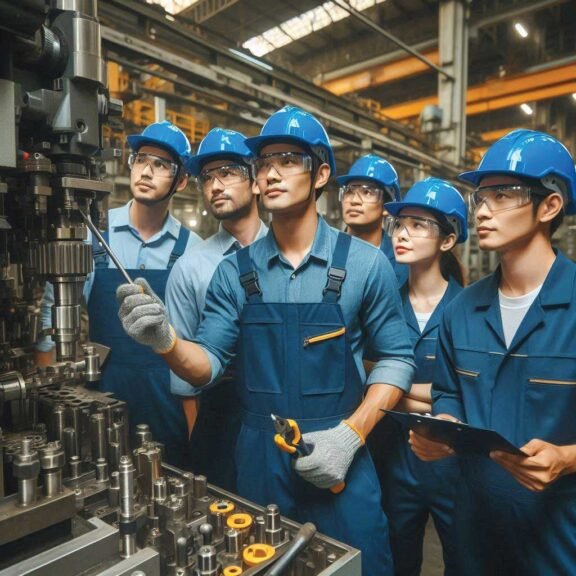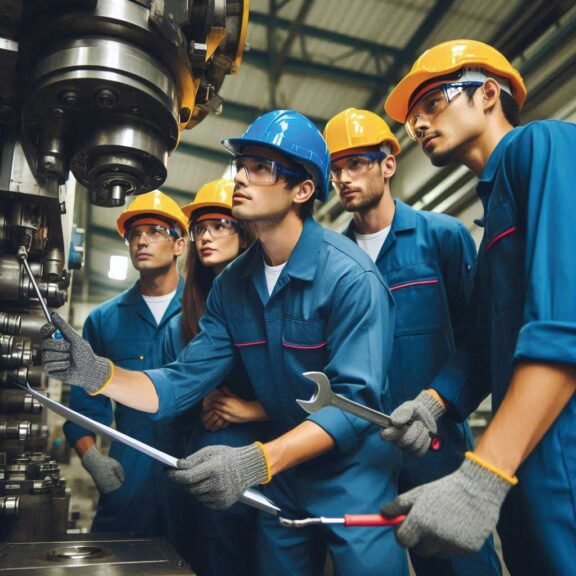Preventive maintenance (PM) is a proactive approach to maintaining equipment, machinery, and systems to ensure they operate efficiently and avoid unexpected breakdowns. By conducting regular inspections, cleaning, lubrication, and necessary repairs, preventive maintenance aims to extend the life of assets and prevent costly repairs or replacements. This guide provides a comprehensive overview of preventive maintenance, its definition, meaning, benefits, and the steps involved in creating an effective preventive maintenance plan.
Preventive Maintenance Meaning
At its core, preventive maintenance refers to scheduled maintenance tasks performed regularly to avoid the risk of equipment failure. Rather than waiting for a machine to break down, preventive maintenance focuses on identifying potential problems early and addressing them before they become critical. It helps minimize downtime, improve efficiency, and ensure safety in various industries, from manufacturing to facilities management.
Quick Overview Of What is Preventive Maintenance
| Aspect | Details |
|---|---|
| Definition | Preventive maintenance (PM) is a proactive approach that involves regular inspection, maintenance, and repairs to prevent unexpected equipment failures. |
| Purpose | To ensure the reliability, safety, and efficiency of equipment and machinery, reducing downtime and repair costs. |
| Key Components | Scheduled Inspections: Routine checks for signs of wear and tear. Cleaning: Removing dirt and debris. Lubrication: Keeping moving parts properly lubricated. Part Replacement: Changing worn-out components before they fail. Calibration: Adjusting equipment to meet operational standards. |
| Benefits | – Reduces unexpected breakdowns – Extends equipment lifespan – Lowers overall maintenance costs – Enhances safety – Increases productivity and efficiency |
| Implementation Steps | 1. Inventory equipment 2. Identify maintenance tasks 3. Create a maintenance schedule 4. Assign responsibilities 5. Monitor and review performance |
| Preventive Maintenance Programs | Structured plans that detail scheduled tasks and integrate maintenance into daily operations. |
| Software Tools | Preventive maintenance software helps automate scheduling, track maintenance history, and analyze performance data. |
| Common Challenges | – Initial cost and time investment – Risk of over-maintenance – Need for trained personnel – Resistance to new practices |
| Conclusion | Preventive maintenance is essential for maintaining operational efficiency, safety, and reliability in various industries. |

Preventive Maintenance Definition
The formal definition of preventive maintenance is the systematic inspection, detection, and correction of potential failures in equipment or systems before they result in unexpected breakdowns. This involves a combination of scheduled maintenance tasks such as lubrication, cleaning, and replacing worn parts to keep equipment in optimal working condition. Preventive maintenance is considered a cost-effective strategy because it reduces downtime and extends the life of assets.
Key Components of Preventive Maintenance
Preventive maintenance includes several key components that are essential for keeping equipment and systems running smoothly. These components include:
1- Scheduled Inspections: Regularly inspecting machinery or equipment to detect signs of wear and tear.
2- Cleaning: Keeping equipment clean to prevent the buildup of dirt and debris that can cause damage over time.
3- Lubrication: Ensuring that moving parts are properly lubricated to reduce friction and wear.
4- Part Replacement: Replacing worn-out or damaged parts before they fail.
5- Calibration: Ensuring that equipment is operating within the correct specifications.
Discover essential mechanical maintenance types and techniques in our comprehensive guide. Whether you’re a novice or expert, this article ensures your equipment runs smoothly. Dive in for expert insights!
Importance of Preventive Maintenance
Preventive maintenance plays a crucial role in reducing unexpected breakdowns and increasing the reliability of equipment. It ensures that assets perform at their best while reducing long-term operational costs. Without a preventive maintenance plan, equipment may fail prematurely, leading to costly repairs, downtime, and even safety hazards.
Here are a few key benefits of preventive maintenance:
Reduced Downtime: Regular maintenance helps prevent sudden equipment failures, resulting in less unplanned downtime.
Cost Savings: By catching small issues before they escalate, businesses can save on expensive repairs or replacements.
Increased Equipment Lifespan: Properly maintained equipment lasts longer, reducing the need for frequent replacements.
Improved Safety: Well-maintained equipment is safer to operate, reducing the risk of accidents and injuries.
Enhanced Productivity: Preventive maintenance ensures that equipment operates efficiently, minimizing disruptions to workflow.

How to Create a Preventive Maintenance Plan
A preventive maintenance plan is essential for organizing and scheduling maintenance tasks effectively. Here are the steps to create a robust plan:
Inventory of Equipment: Start by creating a comprehensive list of all the equipment and systems that require preventive maintenance. This includes manufacturing machinery, HVAC systems, vehicles, and other critical assets.
Identify Maintenance Tasks: For each piece of equipment, identify the specific maintenance tasks needed. This could include inspections, lubrication, cleaning, part replacement, or calibration.
Set a Schedule: Establish a schedule for each task based on the manufacturer’s recommendations or industry standards. Some tasks may need to be performed daily, weekly, monthly, or annually.
Assign Responsibilities: Clearly define who will be responsible for performing each maintenance task. This could involve in-house technicians or hiring external service providers.
Record Maintenance Activities: Keep detailed records of all maintenance activities, including the date, type of maintenance performed, and any observations or repairs needed. This helps track the performance of equipment over time.
Monitor Performance: Regularly review the effectiveness of your preventive maintenance plan. Make adjustments as necessary to improve efficiency and address any new issues that arise.
Unlock the full potential of pliers with our deep dive into their types, uses, and maintenance tips. Perfect for both beginners and professionals—read on for practical advice and expert knowledge!
Preventive Maintenance Programs
A preventive maintenance program involves implementing the preventive maintenance plan and integrating it into daily operations. These programs are tailored to the specific needs of an organization and can range from simple checklists to more complex automated systems. A successful program requires commitment from all levels of the organization, clear communication, and continuous improvement.
The key elements of an effective preventive maintenance program include:
Planning: Developing a maintenance schedule based on the specific needs of equipment.
Execution: Ensuring that maintenance tasks are carried out on time and by qualified personnel.
Documentation: Keeping accurate records of maintenance activities, equipment performance, and any issues encountered.
Review: Regularly evaluating the program’s effectiveness and making necessary adjustments.
Preventive Maintenance Software
In modern industries, preventive maintenance software plays a critical role in managing and streamlining maintenance activities. This software helps automate scheduling, track maintenance history, and provide real-time data on equipment performance. It simplifies the process of creating and managing preventive maintenance tasks, making it easier for organizations to stay on top of their maintenance schedules.
Some key features of preventive maintenance software include:
Automated Scheduling: The software automatically generates maintenance schedules based on the equipment’s usage and history.
Asset Tracking: Keep track of all assets and their maintenance needs in one place.
Work Order Management: Streamline the creation and tracking of work orders for maintenance tasks.
Reporting: Generate detailed reports on maintenance activities, costs, and equipment performance.
Mobile Access: Many preventive maintenance software solutions offer mobile access, allowing technicians to view and update tasks from anywhere.
Popular preventive maintenance software includes CMMS (Computerized Maintenance Management Systems), which is widely used in industries such as manufacturing, healthcare, and facilities management. CMMS software provides a centralized platform for managing maintenance tasks, tracking assets, and generating reports.
Planned Maintenance System
A planned maintenance system is closely related to preventive maintenance. In a planned maintenance system, maintenance tasks are scheduled in advance and conducted according to a predefined timeline. The goal is to perform necessary maintenance before equipment fails, ensuring maximum uptime and operational efficiency.
Planned maintenance systems are often integrated into CMMS software, allowing organizations to automate scheduling and track the performance of equipment over time. By using a planned maintenance system, businesses can reduce the risk of unexpected breakdowns and minimize the need for emergency repairs.
Discover the Top 13 Types of Mechanical Tools: Names and Uses in this detailed guide. Perfect for professionals and beginners alike. Dive in to enhance your toolkit knowledge!
Challenges of Preventive Maintenance
While preventive maintenance offers numerous benefits, it also comes with challenges that organizations must address:
Cost and Time Investment: Implementing a preventive maintenance plan requires an initial investment in time and resources. For some businesses, this can be a barrier to adoption, especially if they lack the necessary personnel or budget.
Over-Maintenance: In some cases, equipment may be over-maintained, leading to unnecessary costs and wasted time. It’s important to strike a balance between too much and too little maintenance.
Lack of Expertise: Preventive maintenance requires skilled technicians who can perform inspections, repairs, and maintenance tasks correctly. A lack of expertise can lead to ineffective maintenance and equipment failures.
Resistance to Change: Employees or management may resist adopting a preventive maintenance program due to a focus on short-term productivity over long-term benefits.

10 Amazing Benefits of Preventive Maintenance
Preventive maintenance is a proactive approach that focuses on regularly scheduled inspections and maintenance tasks to ensure equipment and machinery operate efficiently. By identifying potential issues before they escalate into significant problems, organizations can significantly reduce downtime and maintenance costs. This strategy not only enhances the reliability and safety of operations but also extends the lifespan of assets.
Here, we explore ten amazing benefits of implementing a preventive maintenance program.
1- Reduced Downtime: Regular maintenance helps identify and address potential issues before they lead to equipment failure, minimizing unexpected downtime and ensuring smooth operations.
2- Cost Savings: Preventive maintenance reduces the likelihood of costly repairs and emergency service calls. By addressing small issues proactively, organizations can avoid significant expenses associated with major breakdowns.
3- Extended Equipment Lifespan: By performing regular maintenance tasks, equipment can operate efficiently for a longer period, delaying the need for costly replacements.
4- Improved Safety: Regular inspections and maintenance help ensure that equipment operates safely, reducing the risk of accidents and injuries in the workplace.
5- Enhanced Efficiency: Well-maintained equipment operates at optimal performance levels, improving productivity and energy efficiency, which can lead to lower operational costs.
6- Higher Quality Output: Equipment that is regularly maintained is less likely to produce defective products, leading to improved quality control and customer satisfaction.
7- Better Compliance: Many industries have regulatory requirements regarding equipment maintenance. A preventive maintenance program ensures compliance with these regulations, reducing the risk of fines and legal issues.
8- Increased Reliability: With a preventive maintenance approach, equipment is less likely to fail unexpectedly, which builds trust in the reliability of the machinery and the organization’s operations.
9- Streamlined Operations: A structured maintenance schedule allows for better planning and coordination of resources, leading to smoother operations and reduced disruptions.
10- Data-Driven Decisions: Implementing preventive maintenance often involves tracking maintenance activities and performance metrics, providing valuable data that can inform future maintenance strategies and investments.
Join us as we delve into Exploring 10 Types of File Tools (Pictures): Materials and Uses in this informative guide. Learn about different file tools, their materials, and practical applications. Perfect for anyone looking to expand their tool knowledge!
Conclusion
Preventive maintenance is a proactive and cost-effective approach to maintaining equipment and systems. By conducting regular inspections, performing repairs, and keeping assets in good working condition, organizations can reduce downtime, extend equipment life, and improve overall safety. Creating a preventive maintenance plan, implementing preventive maintenance programs, and using software like CMMS can streamline the process and ensure long-term success.
Whether you are maintaining industrial machinery, vehicles, or building systems, preventive maintenance is essential for minimizing disruptions and maximizing productivity. Investing time and resources into a well-structured preventive maintenance plan today can lead to significant cost savings and operational improvements in the future.

